The product recommendations in this post are recommendations by the writer and/or expert(s)
interviewed and do not contain affiliate links. Meaning: If you use these links to buy
something, we will not earn a commission.
There’s no doubt that ramen is delicious, however, the instant varieties aren’t always as nutritious as you wish they could be. Beyond that, they may actually contain concerning amounts of iffy ingredients. On the other hand, there are some pre-made options that tone down the questionable additions without sacrificing the taste. That’s why ramen lovers would surely like to know what the best and worst instant products are, and we’ve tracked down that info with the help of a nutritional expert.
So, what makes some ramen healthier than others? “A healthy ramen can be made from whole grain or whole wheat flour,” Catherine Gervacio, RDN and nutrition writer for Living.Fit, tells Eat This, Not That! “These provide more fiber and nutrients compared to refined flour noodles. A lower sodium content can make it healthier as well especially if it has about less than 600 milligrams of sodium per serving. Some instant ramen products come with dehydrated vegetables. These can add fiber, vitamins, and minerals to the meal.”
As for ramen which is arguably unhealthy, Gervacio says that it tends to have “a high sodium amount and contains refined flour.” Beyond that, she notes that “some have sauces with added sugar” while explaining that “ramen is not typically sweet, so added sugars may be an unhealthy addition.” That’s not to mention the fact that “the fat content of these ramen can raise cholesterol levels and contribute to heart disease,” Gervacio tells us while saying, “Avoid ramen products with high levels of saturated fat and trans fats. Cheaper brands may not contain any substantial sources of nutrients like protein or vegetables.”
How we chose the healthiest instant ramen
For a clear picture of how to shop for the best healthy ramen brands, we looked for these four benchmarks:
- Made from whole grain or whole wheat flour
- Comes with dehydrated vegetables
- Relatively low in sodium
- Relatively low in calories
With these in mind, Gervacio helped us pick out the best healthy instant ramen and the worst you should avoid. Read on, and for more, don’t miss 10 Unhealthiest Pasta Sauces on Grocery Shelves, According to Dietitians.
Best Instant Ramen
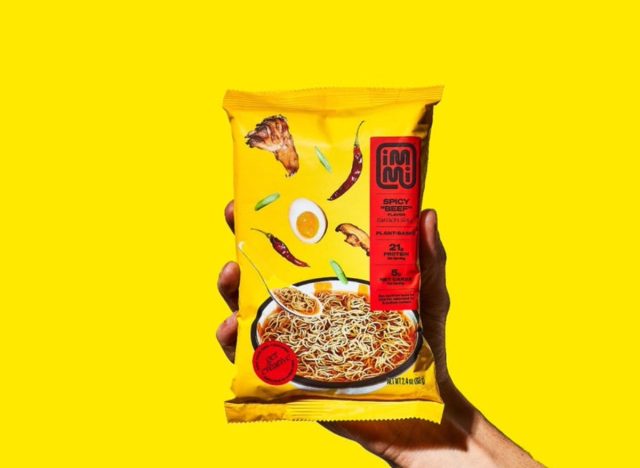

Per meal: 300 calories, 14 g fat (7 g saturated fat), 890 mg sodium, 24 g carbs (19 g fiber, 1 g sugar), 21 g protein
When it comes to why Immi Spicy “Beef” Ramen is among the healthiest ramen options on store shelves, Gervacio says that “it is a very good plant-based ramen that has a high protein and fiber level” while also being “a low carbohydrate content.” For those who need to keep an eye on their weight, Gervacio also points out that “the total calories, about 300 is also a good number.”
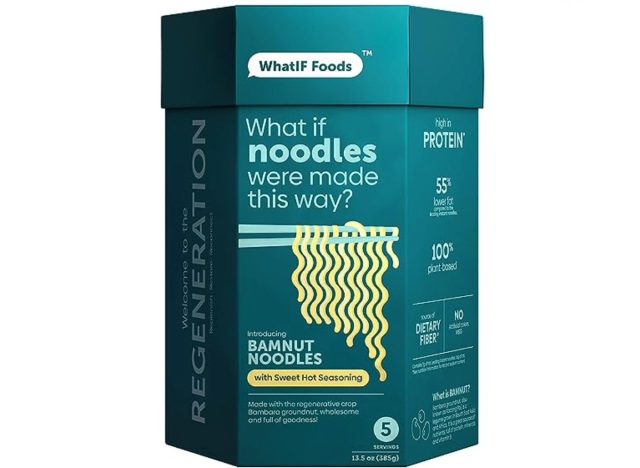

Per meal: 300 calories, 7 g fat (3 g saturated fat), 720 mg sodium, 42 g carbs (6 g fiber, 7 g sugar), 17 g protein
“These noodles offer a different and healthier take to wheat-based ones,” Gervacio says while discussing WhatIf Foods BAMnut Noodle. An option that can often be seen in Asian noodle dishes, a study published by the Cereal Chemistry journal in August 2018 noted that whole wheat noodles can offer both a satisfying eating experience as well as one that’s nutritious. Gervacio adds, “These are good options for those who have certain sensitivities to gluten. It is also vegan-friendly which means it contains no cholesterol. Also has lower sodium content than immi.”
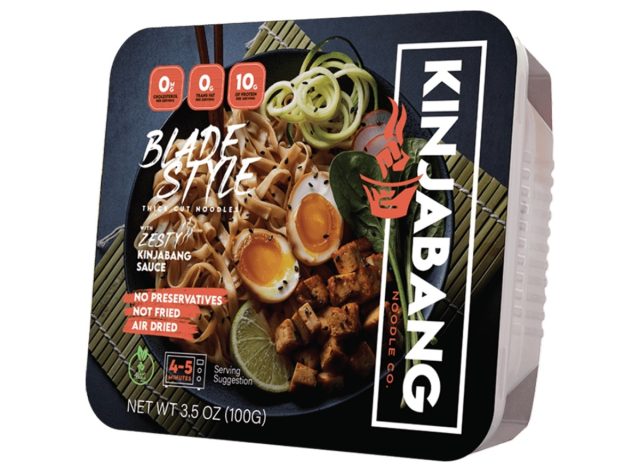

Per meal: 290 calories, 0 g fat (0.005 g saturated fat), 460 mg sodium, 63 g carbs (3 g fiber, 4 g sugar), 10 g protein
Kinjabang Blade Style Thick Cut Noodles offers you a zesty flavoring that contains soya sauce, shallots, and black vinegar, as well as a vegetable packet with dried cabbage, carrot, fungus, mushroom, and green onion. At the same time, Gervacio says, “This is also a vegan-friendly noodle and has a low total fat content. The protein amount is moderate so it’s good.”
“However, they contain a high sodium content,” she also notes. “Their Shadow Style flavor has 1,360 mg of sodium and already meets 59% of the recommended intake in one serving. There’s also added sugar which may not be suitable for managing a high blood sugar level.”
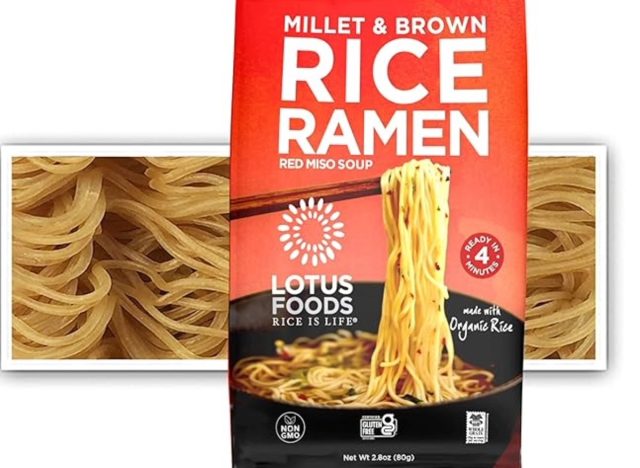

Per meal: 120 calories, 1.5 g fat (0 g saturated fat), 0 mg sodium, 23 g carbs (2 g fiber, 0 g sugar), 4 g protein
READ RELATED: Michael J. Fox Used Alcohol and Pills ‘to Hide’ From Parkinson’s Diagnosis
Lotus Foods Organic Millet & Brown Rice Ramen “is very good for those who are looking for gluten-free alternatives,” Gervacio says. While the noodles in Lotus Foods’ Ramen are made of specialty brown rice, a study published in the February 2013 issues of Critical Reviews in Food Science and Nutrition found that brown rice in general is healthier than white rice. Gervacio explains that when it comes to the Organic Millet & Brown Rice Ramen, “It has a low sugar, carbohydrate, and fat content, but the amount of protein is low.” Because of that, “a serving of lean proteins can be considered when eating these noodles. Also, it has a low fiber content so adding vegetables is optimal.”
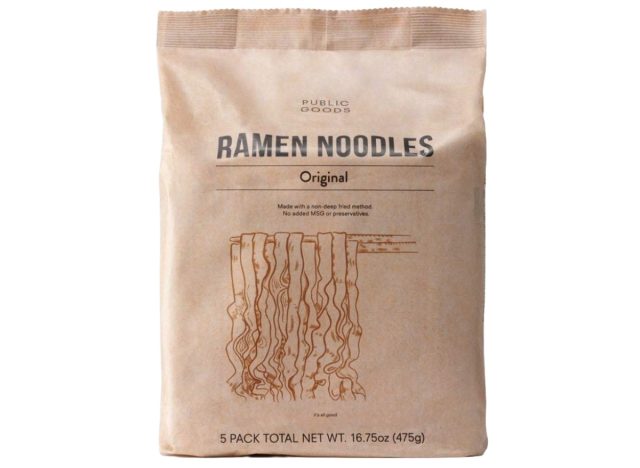

Per meal: 290 calories, 3 g fat (0.4 g saturated fat), 1,510 mg sodium, 58 g carbs (2 g fiber, 7 g sugar), 10 g protein
Gervacio first points out that among the healthy options, Public Goods Original Ramen Noodles “has the highest sodium content of 1,510 milligrams per serving, which accounts for 66% of the total recommended daily intake,” per the United States Food and Drug Administration (FDA). However, she also tells us that “it has a reasonable number of calories,” is “low in fat,” and includes protein as well as “moderate carbohydrates” which means that it’s still a better choice than the worst options on this list.
Worst Instant Ramen
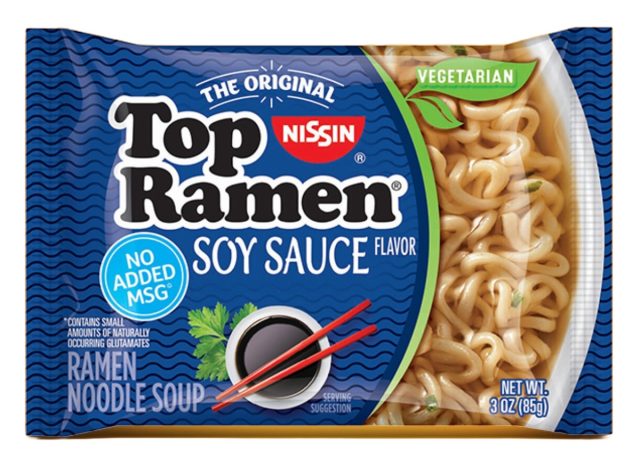

Per meal: 380 calories, 14 g fat (6 g saturated fat), 1,620 mg sodium, 53 g carbs (2 g fiber, 0 g sugar), 9 g protein
Although Nissin Top Ramen Soy Sauce Flavor is appropriate for vegetarians and anyone who stays away from meat, while also claiming to have a reduced sodium content and no added MSG, it still has quite a bit of sodium at 1,620 milligrams. That’s not to mention that it has 380 calories which is 80 calories more than a McDonald’s cheeseburger, 50 more calories than the Subway Veggie Delite® wrap, and 20 calories more than a Chalupa Supreme® from Taco Bell.
RELATED: 83 Unhealthiest Fast Foods On the Planet
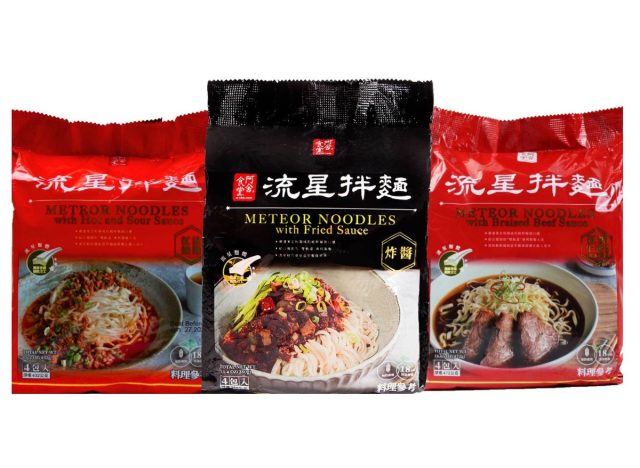

Per meal: 390 calories, 9 g fat (4 g saturated fat), 2,000 mg sodium, 65 g carbs (3 g fiber, 6 g sugar), 12 g protein
A-Sha Meteor Noodles with Braised Beef Sauce is made with “a one-of-a-kind ramen noodle” that will apparently “elevate your ramen experience.” Granted, it does so with 390 calories and 2,000 milligrams of sodium which means that the salty content of Meteor Noodles and Braised Beef Sauce is out of this world, and not in a good way.
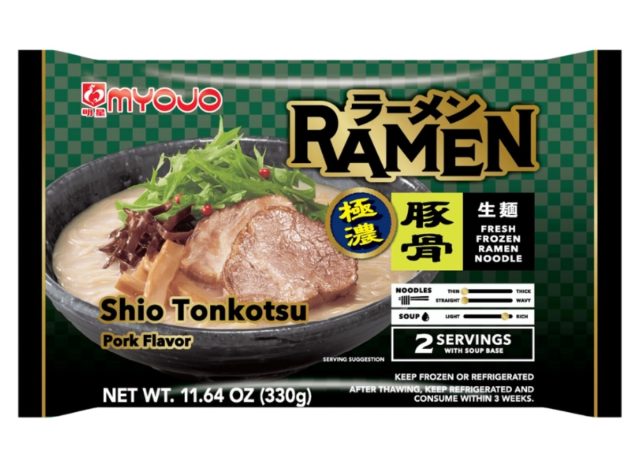

Per meal: 400 calories, 7 g fat (2 g saturated fat), 3,150 mg sodium, 67 g carbs (2 g fiber, 3 g sugar), 12 g protein
Myojo Premium Shio Tonkotsu Ramen offers a creamy pork broth along with toppings like chashu, kikurage mushroom, and seasoned bamboo. Unfortunately, this ramen dish also has 400 calories. Granted, that can’t compare to the fact that it also has a whopping 3,150 milligrams of sodium which is obviously way too much for one meal let alone a single ramen dish.
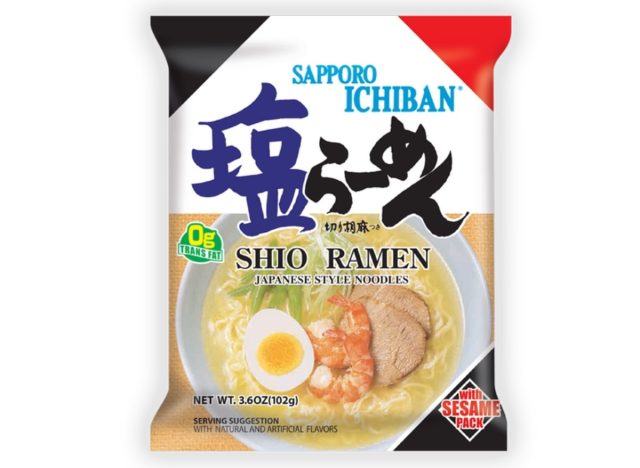

Per meal: 460 calories, 18 g fat (8 g saturated fat), 2,140 mg sodium, 64 g carbs (4 g fiber, 3 g sugar), 9 g protein
Sanyo Foods Sapporo Ichiban Shio Ramen tries to win you over with the fact that it’s trans-fat-free and achieves its flavor with the help of the “natural sweetness and flavor of vegetables” that are meant to be added to the “refreshing clear soup.” However, you shouldn’t overlook the fact that it also has 460 calories and 2,140 milligrams of sodium.
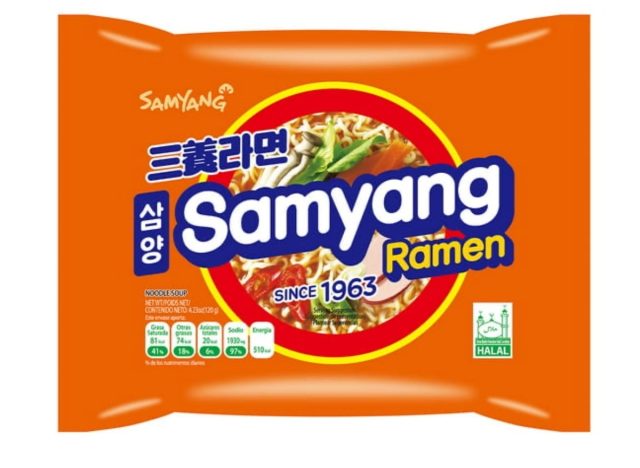

Per meal: 510 calories, 17 g fat (9 g saturated fat), 1,930 mg sodium, 78 g carbs (n/a g fiber, 5 g sugar), 10 g protein
Samyang Ramen has apparently been around and providing those who adore this dish with “heartwarming rich broth and deliciously bouncy noodles” since 1963. Yet, in all of those years, they haven’t seemed to come up with a recipe that’s on the healthier side. Instead, the ramen includes 510 calories and 1,930 milligrams of sodium.











